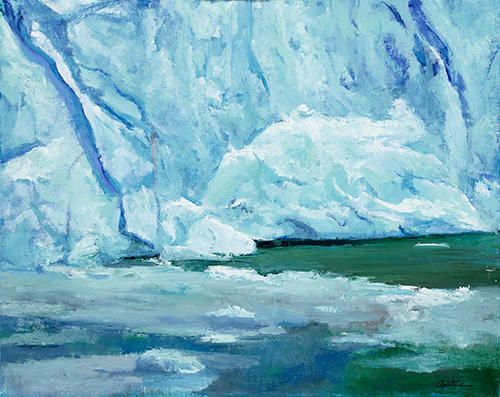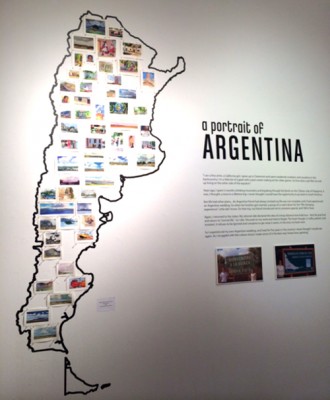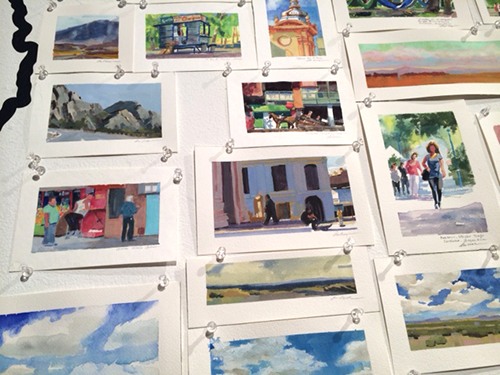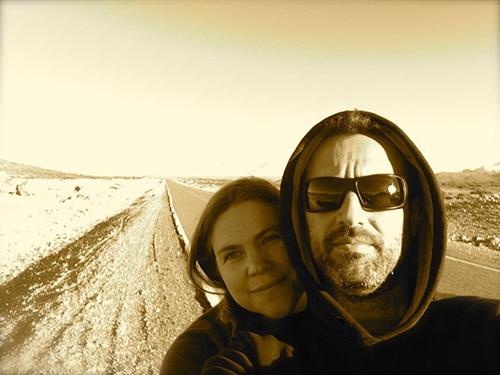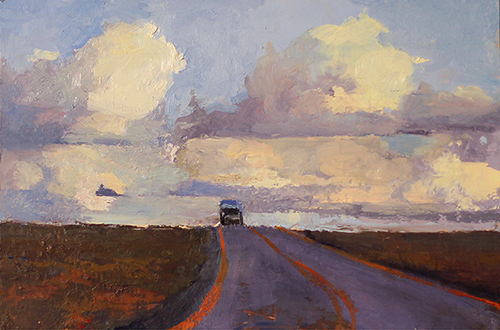The Dotted Line caught up with Alumna Antrese Wood (BFA 94 Illustration) at the opening of her show, “A Portrait of Argentina” at the dA Center for the Arts in Pomona.
Dotted Line: What have you been doing personally since you left Art Center?
Antrese Wood: I’ve had a windy path.
I left Art Center and worked for Disney for about 12 years. I got that job by being extraordinarily persistent, possibly stalker-ish. Sometimes, I wondered if they hired me so I’d finally leave them alone.
Working at Disney allowed me to mature and continue to develop skills I learned at Art Center. The real lesson in all the class critiques is not so much about the details of the work itself; it’s about being able to objectively talk about the work. To listen to other people’s opinions about your ‘baby’ without taking it personally or getting defensive. Part of my job at Disney was providing art direction for video games. I can tell you the people who did not pick up that skill were not happy and did not make it very far.
I left Disney because I wanted to pursue my own work. It took me a long time to pull the trigger—I’d stall and wait for a project to finish, or bonuses to come in, or for the weather to be right—my procrastination got a little ridiculous but I was relieved when I finally pushed past my resistance.
Not long after, two things happened—the stock market crash of 2008 and meeting my husband to be. I didn’t understand the implications of either at first but both had a pretty big impact. I was doing great with my artwork and wondering why I hadn’t gone solo sooner before the stock market crashed. Afterwards, I had to learn quickly to be savvier with getting my work out and marketing myself. That was an important lesson.
After I got married I moved to Argentina, where my husband is from. I had to learn a new language, how to get around in a new culture and basically re-invent myself. That’s when I came up with the idea of ‘A Portrait of Argentina’ and started a Kickstarter campaign, raising just over $25,000 to paint my way across my adopted country.
DL: Tell us about funding such a journey through Kickstarter. It is an unusual use of the crowdfunding platform.
AW: At the time, there were not many painting projects that were as ambitious as mine. I had no idea if this was something people would respond to so I liked the fact that on Kickstarter, if I couldn’t raise the funds, no one would be charged. ‘A Portrait of Argentina’ was such a massive undertaking; I didn’t want to do it half way.
I was surprised at the people who donated and who really rallied to support me. I had people from all walks of life and all over the world. One thing I realized early was that you couldn’t assume people understand the technology. I am an early adopter and I would guess, by the nature of Art Center, most students and alumni are as well.
But not everyone is. My mother is a good example. She is almost 80 now and she’s pretty good on the computer but not fluent. Many of her friends and colleagues rallied around the project so I created videos and printed instructions describing what exactly crowdsourcing is and made a step-by-step guide to show them how to donate. This experience taught me how important it is to get outside of your own head, and to think about the obstacles people outside of your peer group may face.
I spent about five weeks developing the project, flushing out the budget and getting the pieces of the campaign together. The campaign itself lasted another five weeks.
DL: What has been the response to the project?
AW: I get notes and comments from people who followed the project from the beginning and people who have just discovered it through my Facebook page and the exhibition. The response has been remarkable. The many Argentinos who live in the United States continually surprise me—the paintings evoke a very emotional reaction from them.
It’s an incredibly beautiful country and unique in the landscapes. It changes dramatically from the north to the south and people who have traveled through there, who have made the trip along Ruta 40 which runs from Bolivia down to Tierra del Fuego know how tough that trip is and how precious the area is.
I will continue to work on this subject for years. I feel like I have only scratched the surface.
DL: You stayed in people’s homes during this trip. How did that work?
AW: Argentina has a very fly-by-the-seat-of-your-pants culture. People don’t plan ahead and if you try to make reservations too early; it just doesn’t work. So I would get to a town, go to the tourist info center—which fortunately is often open late, and start asking around. In these rural towns the Airbnb is a bulletin board with Xerox fliers or handwritten index cards. I’d ask around—‘Where can I stay? If your sister or cousin needed a place to stay, where would you send her?’ That way I knew I would get a good, safe recommendation. I never had any problems.
Later when my husband came with me, we would sleep in the car a lot. We took out the back seat of the Corolla and made a bed. Just so we could drive further and not worry about rolling into a town at 1 a.m.
DL: What are your most reliable and/or unlikely sources of inspiration?
AW: I do a weekly podcast called the Savvy Painter in which I interview other artists about their careers and work. I started these interviews as a way to give back and contribute to the artist community but they turned out to be enormously inspiring. I usually ask the artist what has been their biggest struggle and, more importantly, what they learned from it.
Artists tend to be alone in their studios and it’s so easy to think you’re a special snowflake. Meaning that whatever struggles you have are unique to you and you are all alone with them. So the Savvy Painter interviews have taught me that I’m not alone, other artists have experienced the exact same thing. It’s normal. And that brick wall I may see in front of me at times is actually just a little speed bump. No big deal.
DL: Are there any lessons learned from social media fundraising?
AW: When I started this project, I had very few social media followers. I used social media mainly to stay in touch with friends family, and a handful of collectors.
Since this project, I’ve learned to harness the power of social media. It’s a game changer for artists to be able to find and connect directly with collectors. The next five years I think will be very interesting as galleries learn to navigate this new reality. That’s something we talk a lot about on Savvy Painter.
I have been very lucky; I developed relationships with influencers. Pamela Slim, for example, is an author and business coach and she mentioned my campaign several times on her blog and in a video. One of her friends, Natalie Sisson ended up doing an article for Forbes, which used “A Portrait of Argentina” as a case study.
Later, Pamela talked about our conversation in her book, “Body of Work.” The ripple that created was enormous.
Another interesting side note on social media—the United States embassy in Argentina noticed my work through Pinterest and I’ve since been in contact with them and they have been sharing my work.

